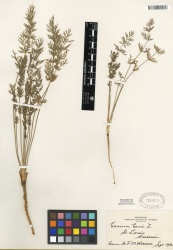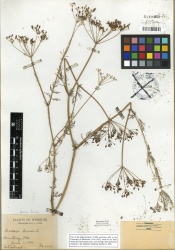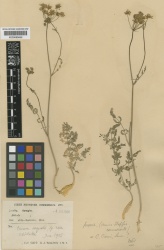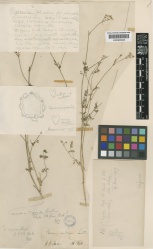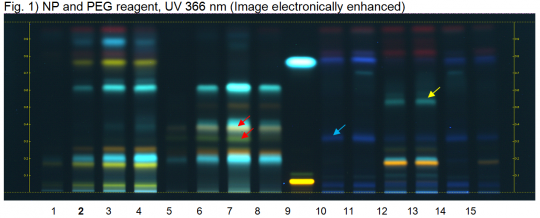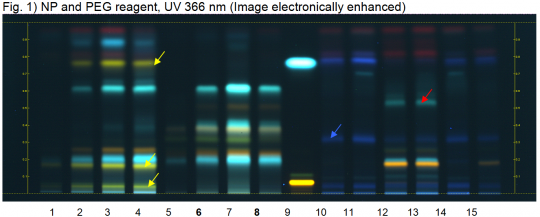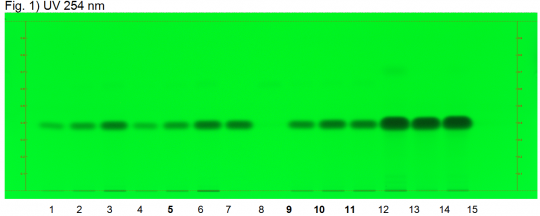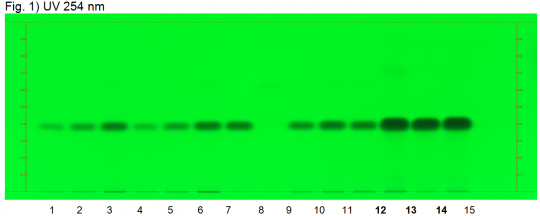Carum carvi (fruit)
Contents |
Nomenclature
Carum carvi L. Apiaceae
Standardized common name (English): caraway
Ayurvedic name(s): krishna jiraka
Botanical Voucher Specimen
 |
 |
||
|
|
|
|
|
Organoleptic Characteristics
|
Macroscopic Characteristics
|
Microscopic Characteristics
|
High Performance Thin Layer Chromatographic Identification
|
Anise fruit (seed) (Pimpinella anisum) Lane Assignments Lanes, from left to right (Track, Volume, Sample):
Reference Sample(s) Reference: Dissolve 3 mg of rutin in 1 mL of methanol. Dissolve 1 mg of caffeic acid in 1 mL of methanol. Stationary Phase Stationary phase, i.e. Silica gel 60, F254 Mobile Phase Ethyl acetate, formic acid, water 15:1:1 (v/v/v) Sample Preparation Method Sample: Mix 500 mg of powdered sample with 5 mL of methanol and sonicate for 10 minutes, then centrifuge or filter the solutions and use the supernatants / filtrates as test solutions. Derivatization reagent: NP and PEG reagent; Preparation NP reagent: 1 g of natural products reagent in 200 mL ethyl acetate; Preparation PEG reagent: 10 g of polyethyleneglycole 400 in 200 mL dichloromethane; Use: Heat for 3 min to 100°C, dip (time 0, speed 5) in NP reagent while still hot, dry, dip in PEG reagent. Detection Method Saturated chamber; developing distance 70 mm from lower edge; relative humidity 33% Other Notes Images presented in this entry are examples and are not intended to be used as basis for setting specifications for quality control purposes. System suitability test: Rutin: orange fluorescent zone at Rf ~ 0.07; Caffeic acid: light bluish fluorescent zone at Rf ~ 0.77. Identification: Compare result with reference images. The fingerprint of the test solution is similar to that of the corresponding botanical reference sample. Additional weak zones may be present. In the upper part of the chromatogram there are three prominent zones: a light blue zone at Rf ~ 0.88, a yellow zone at Rf ~ 0.76 and a light blue zone at Rf ~ 0.61. In the lower part of the chromatogram there is a sequence of three zones (yellow, light blue, yellowish) between Rf ~ 0.15 and 0.26. Right above the application position there is a yellow zone. Test for adulteration: In the middle of the chromatogram there are neither yellow zones at Rf ~ 0.32 and Rf ~ 0.38 (red arrows, Caraway fruit) nor a faint dark blue zone at Rf ~ 0.32 (blue arrow, Bitter Fennel fruit) nor a light blue zone at Rf ~ 0.53 (yellow arrow, Sweet Fennel fruit).
|
|
Caraway fruit (flavonoids) (Carum carvi) Lane Assignments Lanes, from left to right (Track, Volume, Sample):
Reference Sample(s) Reference: Dissolve 3 mg of rutin in 1 mL of methanol. Dissolve 1 mg of caffeic acid in 1 mL of methanol. Stationary Phase Stationary phase, i.e. Silica gel 60, F254 Mobile Phase Ethyl acetate, formic acid, water 15:1:1 (v/v/v) Sample Preparation Method Sample: Mix 500 mg of powdered sample with 5 mL of methanol and sonicate for 10 minutes, then centrifuge or filter the solutions and use the supernatants / filtrates as test solutions. Derivatization reagent: 1.) NP reagent, Preparation: 1 g of natural products reagent in 200 mL ethyl acetate; 2.) PEG reagent, Preparation: 10 g of polyethylene glycol 400 in 200 mL dichloromethane, Use: Heat plate 3 min at 100°C, then dip (time 0, speed 5) in NP reagent while still hot, dry and dip (time 0, speed 5) in PEG reagent. Detection Method Saturated chamber; developing distance 70 mm from lower edge; relative humidity 33% Other Notes Images presented in this entry are examples and are not intended to be used as basis for setting specifications for quality control purposes. System suitability test: Rutin: orange zone at Rf ~ 0.07; Caffeic acid: light bluish zone at Rf ~ 0.77 Identification: Compare result with reference images. The fingerprint of the test solution is similar to that of the corresponding botanical reference sample. Additional weak zones may be present. The chromatogram of the test solution shows a brown zone at Rf ~ 0.23 and a light blue zone right above it at Rf ~ 0.20. Between Rf ~ 0.30 and 0.41 there are three zones (yellowish, brownish and light blue). Above these zones a weak brown zone at Rf ~ 0.51 is present and a light blue zone at Rf ~ 0.61 is seen. Test for other species: No yellow zone is seen at Rf ~ 0.04, 0.16 and 0.76 (yellow arrows, Anise fruit). No greenish blue zone is seen at Rf ~ 0.53 (red arrow, Sweet Fennel fruit) and no blue zone is seen at Rf ~ 0.32 (blue arrow, Bitter Fennel fruit).
|
|
Caraway (fruit) (Carum carvi) Lane Assignments Lanes, from left to right (Track, Volume, Sample):
Reference Sample(s) Reference: Dissolve 2 µL of carvone in 1 mL of ethyl acetate. Dissolve 5 µL of olive oil in 1 mL of ethyl acetate. Stationary Phase Stationary phase, i.e. Silica gel 60, F254 Mobile Phase Ethyl acetate, toluene 5:95 (v/v) Sample Preparation Method Sample: Mix 1 g of powdered sample with 10 mL of methanol and sonicate for 10 minutes, then centrifuge or filter the solutions and use the supernatants / filtrates as test solutions. (Caraway oil: Dissolve 40 µL of sample in 1 mL of toluene.) Derivatization reagent: Anisaldehyde reagent; Preparation: 170 mL of ice cooled methanol are mixed with 20 mL of acetic acid, 10 mL of sulfuric acid and 1 mL of anisaldehyde; Use: Dip (time 0, speed 5), heat at 100°C for 4 min. Detection Method Saturated chamber; developing distance 70 mm from lower edge; relative humidity 33% Other Notes Images presented in this entry are examples and are not intended to be used as basis for setting specifications for quality control purposes. System suitability test: Carvone: a brown zone at Rf ~ 0.39 (WRT); Olive oil: a violet zone at Rf ~ 0.62 (WRT) Identification: Compare result with reference images. The fingerprint of the test solution is similar to that of the corresponding botanical reference sample. Additional weak zones may be present. Under UV 254 nm the chromatogram of the test solution shows a quenching zone at the position of carvone reference substance at Rf ~ 0.39. After derivatization there is a brown zone at the position of carvone at Rf ~ 0.39 and a violet zone at the position of the olive oil reference substance at Rf ~ 0.62. Furthermore there is a weak violet zone close to the solvent and another violet zone at Rf ~ 0.14 (black arrows). Test for Caraway essential oil: After derivatization no blue violet zones are present below the position of carvone (red arrow). Source: HPTLC Association [10] |
|
Caraway oil (fruit) (Carum carvi) Lane Assignments Lanes, from left to right (Track, Volume, Sample):
Reference Sample(s) Reference: Dissolve 2 µL of carvone in 1 mL of ethyl acetate. Dissolve 5 µL of olive oil in 1 mL of ethyl acetate. Stationary Phase Stationary phase, i.e. Silica gel 60, F254 Mobile Phase Ethyl acetate, toluene 5:95 (v/v) Sample Preparation Method Sample: Dissolve 40 µL of sample in 1 mL toluene. (Caraway fruit: Mix 1 g of powdered sample with 10 mL of methanol and sonicate for 10 minutes, then centrifuge or filter the solutions and use the supernatants / filtrates as test solutions.) Derivatization reagent: Anisaldehyde reagent; Preparation: 170 mL of ice cooled methanol are mixed with 20 mL of acetic acid, 10 mL of sulfuric acid and 1 mL of anisaldehyde. Use: Dip (time 0, speed 5), heat at 100°C for 4 min. Detection Method Saturated chamber; developing distance 70 mm from lower edge; relative humidity 33% Other Notes Images presented in this entry are examples and are not intended to be used as basis for setting specifications for quality control purposes. System suitability test (WRT): Carvone: a brown zone at Rf ~ 0.39; Olive oil: a violet zone at Rf ~ 0.62 Identification: Compare result with reference images. The fingerprint of the test solution is similar to that of the corresponding botanical reference sample. Additional weak zones may be present. Under UV 254 nm the chromatogram of the test solution shows a quenching zone corresponding to the reference material carvone at Rf ~ 0.39. After derivatization there is a brown zone at the position of carvone at Rf ~ 0.39. Above this zone several weak blue-violet zones are present (red arrow). (The reddish-violet zone at Rf ~ 0.19 is carveol). Test for “adulteration”: After derivatization there is no violet zone at the position of the olive oil reference substance at Rf ~ 0.62. Source: HPTLC Association [11] |
Supplementary Information
Sources
- ↑ MOBOT, Tropicos.org http://www.tropicos.org/Image/88617
- ↑ MOBOT, Tropicos.org http://www.tropicos.org/Image/100191838
- ↑ Royal Botanic Gardens, Kew. http://specimens.kew.org/herbarium/K000685656
- ↑ Royal Botanic Gardens, Kew. http://specimens.kew.org/herbarium/K000685658
- ↑ Culbreth, D. (1917) A Manual of Materia Media and Pharmacology, 6th ed.
- ↑ Culbreth, D. (1917) A Manual of Materia Media and Pharmacology, 6th ed.
- ↑ Culbreth, D. (1917) A Manual of Materia Media and Pharmacology, 6th ed.
- ↑ HPTLC Association http://www.hptlc-association.org/
- ↑ HPTLC Association http://www.hptlc-association.org/
- ↑ HPTLC Association http://www.hptlc-association.org/
- ↑ HPTLC Association http://www.hptlc-association.org/
